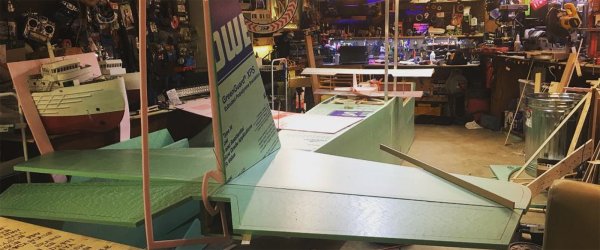[Peter Sripol] is something of a legend in the DIY RC aircraft crowd. He’s friends with Flite Test, and there he built an enormous RC cargo plane that could easily carry a small child aloft. Now, [Peter] is aiming a bit higher. He’s building an ultralight — a manned ultralight — in his basement. It’s made out of insulation foam.
Yes, this ultralight is constructed out of insulation foam, but you can think of that as just a skin. The real structure here comes from a wooden frame that will be fiberglassed. The design of this aircraft is an electric, twin-engine biplane. The relevant calculations have already been done, and [Peter] is already flying an RC scale model of this craft. So far, everything is not as sketchy as it could be.
As with any, ‘guy builds an airplane in his basement’ story, there must be a significant amount of time dedicated to the legality, practicality, and engineering of said plane. First off, the legality. [Peter] is actually building an ultralight under Part 103. The certifications for a Part 103 ultralight are much more lenient than the next step up in FAA-certified aircraft, a light sport or experimental aircraft. An ultralight is not required to have an airworthiness certification, and pilots of ultralights are not required to pass any tests of aeronautical knowledge or hold a medical certificate. Yes, legally, any moron can jump in an ultralight and fly. Think about that the next time someone brings up the Part 107 ‘drone’ certification.
Next, the practicality and engineering. [Peter]’s plane can weigh a maximum of 254 pounds, and should not be capable of more than 55 knots in full power level flight, while having a stall speed that does not exceed 24 knots. This is slow for a Cessna, but just about right for the gigantic remote-controlled planes [Peter] has already built. A few years ago, [Peter] built a gigantic remote-controlled cargo plane out of what is basically foam board and a few aluminum tubes. The construction of [Peter]’s ultralight will be a highly refined version of this. He’s using foam insulation sheets for the body of the fuselage, reinforced with plywood and poplar struts. This foam and wood build will be wrapped with carbon fiber and fiberglass sheet, epoxied, and hopefully painted with flames on the side.
The use of poplar is a bit curious for an ultralight aircraft. For the last hundred years, the default wood for aircraft has been either spruce or douglas fir. The reason for this choice is the strength to weight ratio; spruce and douglas fir have the highest strength to weight ratio of any other wood. Poplar, however, is ultimately stronger and available at his local home improvement store, even though it does weigh a bit more. If [Peter] can keep the weight down in other areas, poplar is an excellent choice due to cost and availability. The video (below) is unclear, but we can only hope [Peter] has read up on the strength of aircraft frames and the orientation of the grain of each structural member.
This is the first video in what will be an amazing build series, and [Peter] hopes to get this thing up in the air by September. If you’re concerned about [Peter]’s safety, he’s also put up a GoFundMe page for a parachute. [Peter]’s going to fly this thing if you complain or concern troll or not, so donate a dollar for the parachute if you’re that concerned.
Continue reading “Building An Ultralight Out Of Foam In A Basement”























